
Medical maintainers play key role in Army’s response to COVID-19
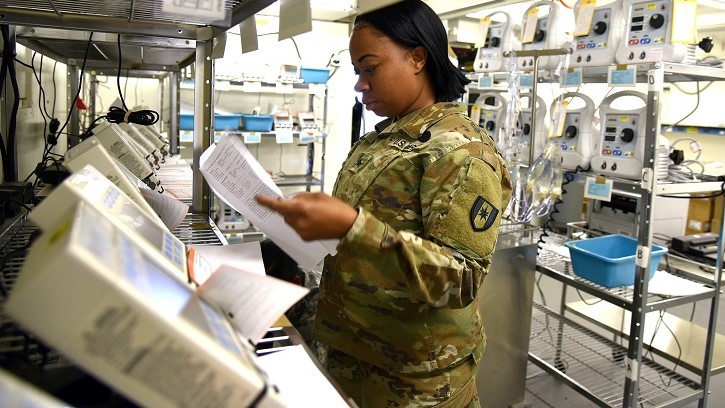
A Soldier from the 28th Combat Support Hospital conducts a joint inventory of medical equipment at Sierra Army Depot in Herlong, California. The inventory was part of a reset leveraging the Medical Materiel Readiness Program. (Photo Credit: Ellen Crown)
FORT DETRICK, Md. -- The COVID-19 pandemic has shined a bright light on health care professions around the world, including those in lifesaving care and support roles for the U.S. Army and Department of Defense.
During the COVID-19 response, those tasked with maintaining complex medical devices have also put in long hours and adapted to changing mission requirements to support patients across the country and abroad.
This team includes specially trained enlisted Soldiers, warrant officers, civilian employees and contractors.
“First, I would like to say thank you,” said Chief Warrant Officer 5 Wendell Johnson, 670A consultant for the Army Surgeon General. “From the battlefields to the medical treatment facilities, you have performed in a way that gives the warfighter the confidence to do their mission knowing that the Military Health System will be there to support them.”
In the field, Soldiers trained as Biomedical Equipment Specialists, or 68As, handle unit-level sustainment of deployed medical devices. They perform maintenance checks, troubleshoot problems and make repairs.
Master Sgt. Wesley Ladlee, a 68A senior enlisted adviser from the 6th Medical Logistics Management Center, said the COVID-19 response has led to increased workloads for 68As, including from other government agencies that do not have organic medical maintenance assets.
“So it’s up to the 68A to inspect those devices to ensure patients are treated and cared for in the safest way possible,” Ladlee said.
Teamed with warrant officers trained as 670As, or Health Services Maintenance Technicians, the two professions provide multifunctional life-cycle support for medical device systems that ensure high-quality patient safety and clinical care outcomes.
“As a community, the 68As and 670As have employed and synced their efforts to enhance equipment readiness and visibility of assets around the country,” Ladlee said.
Additionally, the 670A participates in the procurement process and serves as a technical consultant to hospital staff for maintenance and procurement matters. They ensure devices are safe, reliable and accountable.
Johnson said that without the support and expertise of the global medical maintenance community, “positive patient outcomes would be drastically impacted.”
“The 670A/68A ensures the proper functionality of the medical devices that the healthcare provider uses,” he said. “… As I have said before, this team is a major part of what enables the greatest military health care system in the world to provide the best care for our warfighters on the battlefield and at home.”
At the depot level, civilian teams of Biomedical Equipment Technicians, or BMETs, at the U.S. Army Medical Materiel Agency’s Medical Maintenance Operations Divisions (MMODs) have worked “around the clock” to meet increased demands for ventilators, oxygen generation equipment, infusion pumps and more to support areas hit hard by COVID-19.
“Each and every one of our teammates are literally giving their all and recognize that what they do is critical to the overall lifesaving work that the front-line clinicians are providing,” said Jack Rosarius, director of USAMMA’s Medical Maintenance Management Directorate. “We thank them for that.”
USAMMA, a direct reporting unit to the Army Medical Logistics Command, has three regional MMODs in the U.S., including MMOD-Tobyhanna located at Tobyhanna Army Depot, Pennsylvania.
Technician Bill Wall said “priorities change daily,” but they have “met and exceeded expectations.”
One team of eight BMETs at Tobyhanna, specifically, has been devoted solely to testing and servicing ventilators to support the whole-of-government response. Speaking in late April, Wall said they had completed and returned to service roughly 250 units in about a month’s time.
“They are driven by the knowledge that what we are doing is making an impact to the warfighter and the community,” said Wall, a 12-year USAMMA employee who specializes in laboratory equipment.
Additionally, Wall said the team has handled the increased need for laboratory equipment to support COVID-19 hot spots, including apheresis devices, microbiology analyzers and hematology analyzers.
Rosarius also recognized the procurement staff that are working hard to ensure adequate and timely supply lines for maintenance staff, as well as packers, shippers and production controllers that keep it all moving at each of the three locations.
“And perhaps, most importantly, are the quality assurance folks that ensure we continue to produce the quality product that we always have in spite of the haste to get equipment out,” he said.
USAMMA’s other two MMODs – MMOD-Hill and MMOD-Tracy – are located at Hill Air Force Base, Utah, and Tracy, California. Each site covers a geographical region and/or specializes in specific types of equipment.
Before life-cycle management, there’s acquisitions, contracting and logistics personnel who make sure the right equipment and people get to the right places at the right times.
To that end, Army, Defense Health Agency and Defense Logistics Agency personnel combine efforts to support the Military Health System and coordinate equipment readiness, acquisitions and property accountability.
Chief Warrant Officer 4 Reginald Burrus, senior sustainment officer for DHA-Medical Logistics, said it’s often “a thankless job,” but the response to COVID-19 has shown the great work the medical maintenance community continues to do.
“Our value usually isn’t identified until something happens,” he said.
COVID-19 has caused lifestyle changes, both personal and professional, around the world. And while it’s had an effect, personnel have shown great resolve to adjust while ensuring the patient and safety remains the focus, according to Chief Warrant Officer 4 Charles Judd.
Judd, liaison officer for DLA Troop Support-Medical’s Capital Equipment Division, said it’s important to recognize everything that the medical maintenance community does, which goes far beyond logistics and repairing equipment.
“Safety continues to be the number one priority,” he said. “That’s one issue this pandemic has really brought to life.”
Burrus said the complexity of the medical field creates the need for technicians, logisticians and acquisition specialists to not only “understand the technology, but also the clinical aspect of it.”
“What is the doctor trying to do versus what is his equipment capable of doing? And we also have the opportunity to help them identify the best technology to meet that clinical requirement,” he said. “We’re the middle man to give the doctor what they need, but also to make sure it’s operating safely to ensure the patient has a positive outcome.”
Ladlee said medical maintenance teams continue to provide a monetary value, in the form of savings to the government for sustaining medical devices, although “the true value of the technical expertise 68As and 670As provide Commanders cannot be measured.”
“There is an old motto that ‘Healthcare starts with Medical Logistics.’ I truly believe it does,” he said, adding that medical maintenance personnel have “always been valuable to the force” but COVID-19 has given the community a new chance to shine.
Chief Warrant Officer 5 Jesus Tulud, director of AMLC's Medical Maintenance Policy and Analysis directorate, underscored the appreciation for the continued efforts across the medical maintenance enterprise.
“I cannot say enough about our teams,” he said. “From the lowest rank Soldiers to our senior BMETs, they are all working together to ensure our health care providers have what they need at the right time.”
Using mobile mental health apps to cope during social isolation
Article
5/22/2020
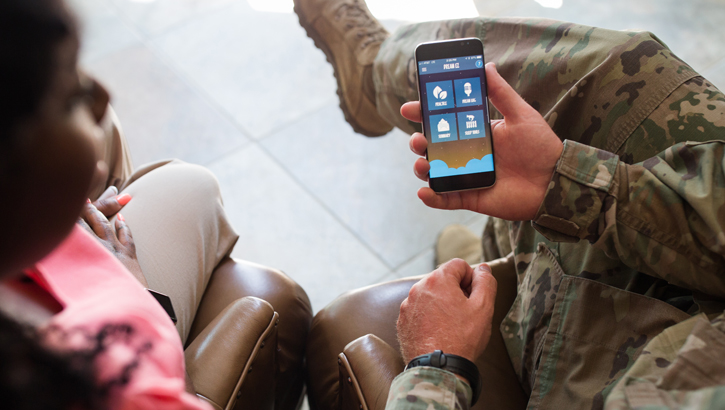
Learn how your smartphone can serve as a lifeline
COVID-19: lifestyle tips to stay healthy during the pandemic
Article
5/22/2020

With this unprecedented lifestyle shift, there is a potential for the normalization of a more sedentary lifestyle.
VENDOR UNSOLICITED PROPOSAL IN SUPPORT OF COVID-19
Form/Template
5/21/2020
Unsolicited Proposal Information Supporting COVID-19
NMHM opens ‘virtual doors’ to the public during COVID-19
Article
5/21/2020
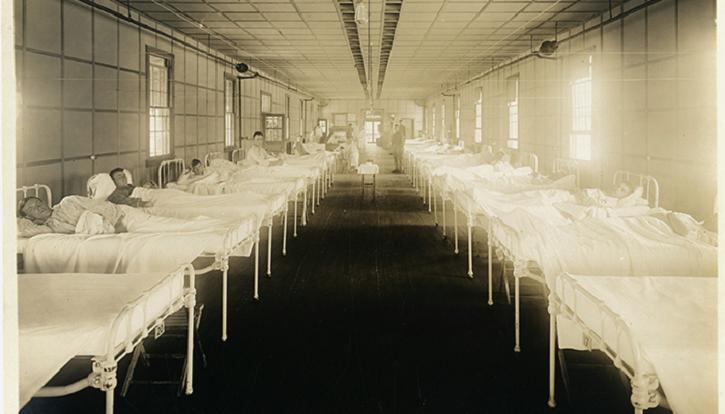
In the current climate of COVID-19 and stay-at-home orders, virtual environments have become an invaluable means of entertainment and education.
Air Force bioenvironmental engineers expand mission in aerovac, workspaces
Article
5/21/2020
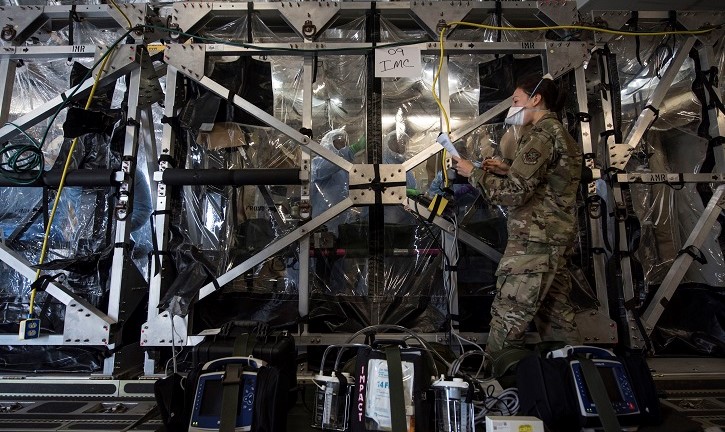
The aeromedical evacuation mission became a top priority as COVID-19 began to spread.
Guidance for Commanders on Risk-Based Changing of Health Protection Condition Levels During the Coronavirus Disease 2019 Pandemic
Publication
5/20/2020
This memorandum provides guidance for commanders to consider when making decisions to change health protection condition (HPCON) levels as COVID-19 pandemic conditions on and adjacent to our installations begin to improve.
NHB/NMRTC Bremerton’s PHEO leans in on COVID-19 pandemic
Article
5/20/2020
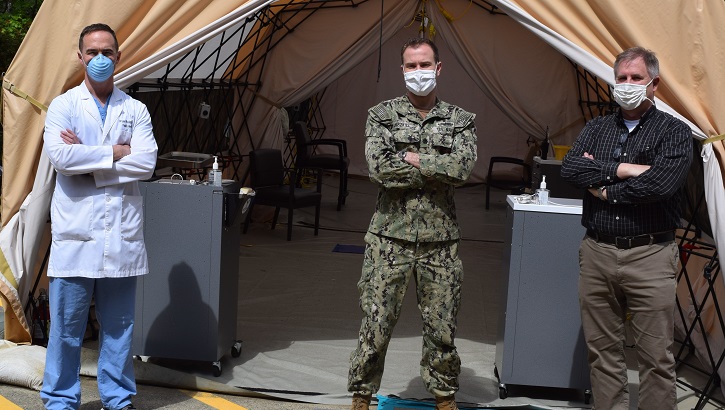
It’s been long days preparing for the unpredictable, limiting the unforeseen and controlling the unexpected.
Resuming Elective Surgical, Invasive, and Dental Procedures in Military Medical and Dental Treatment Facilities
Publication
5/19/2020
This memorandum provides guidance on how each Military Medical Treatment Facility (MTF) and Dental Treatment Facility (DTF) may resume elective medical and dental procedures.
METC creates innovative training to graduate RT students
Article
5/19/2020
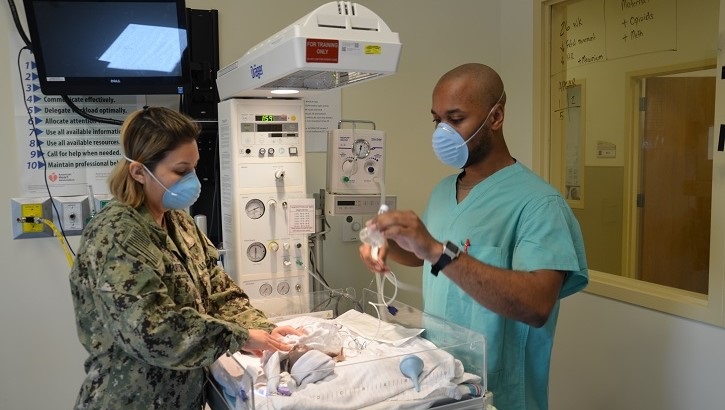
When COVID-19 interrupted phase 2 clinical training a class of Army and Navy respiratory therapist students needed to from the program, their clinical training instructors developed a plan and put it to action.
Military chaplains emphasize spiritual health during COVID-19 pandemic
Article
5/19/2020
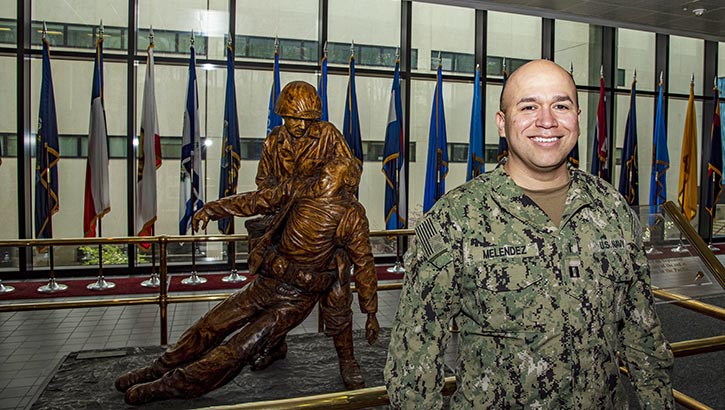
In a time of great fear, spiritual health remains an important domain of Total Force Fitness.
DHA increases access to telehealth during COVID-19 pandemic
Article
5/19/2020
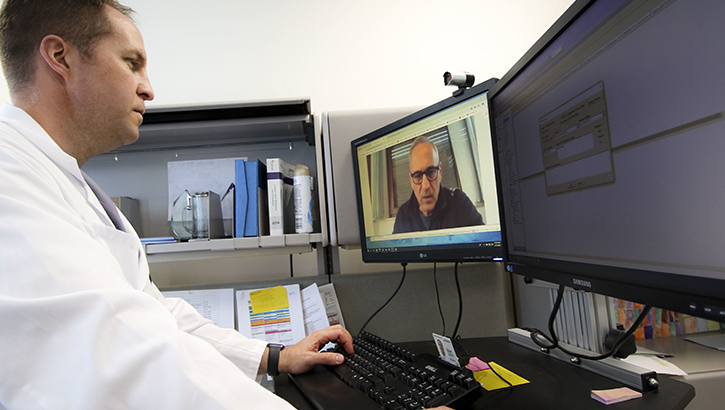
Use of telehealth role increases to prevent COVID-19 spread
RWBAHC Soldier Shows compassion, initiative in COVID-19 Screening
Article
5/18/2020
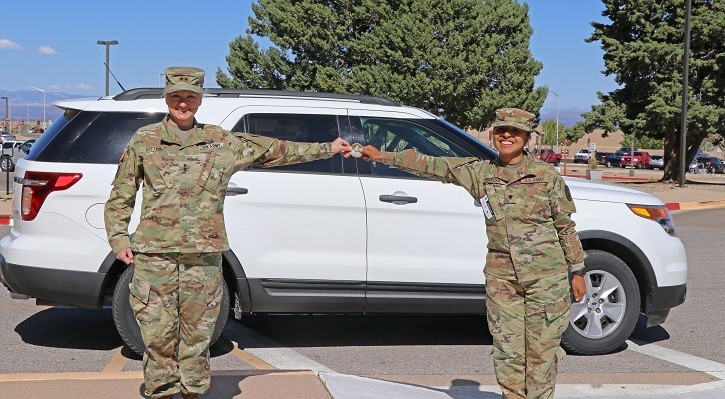
"This type of behavior needs to be highlighted and awarded because it is truly what makes this organization great."
Expert panel on infection control to tackle COVID-19 questions
Article
5/18/2020
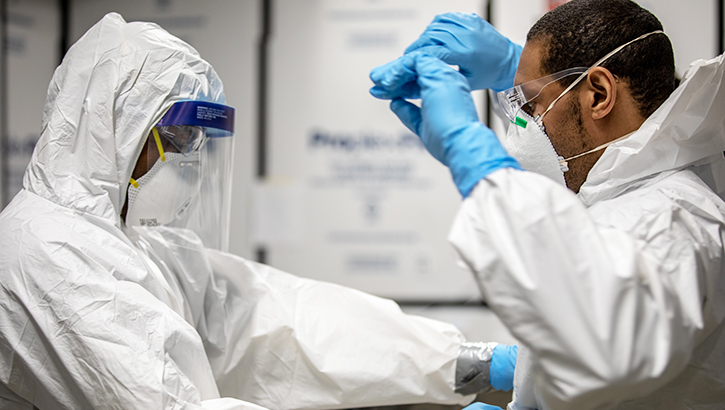
How are patient safety decisions made during the pandemic?
DoD COVID-19 Practice Management Guide Version 3
Technical Document
5/14/2020
This COVID-19 Practice Management Guide has been rapidly and thoughtfully developed by a multi-specialty group of 60 subject matter experts from across the Department of Defense Military Health System. The intent of this publication is to provide clinicians and military medical treatment facilities (MTFs) with best practices based on latest evidence to optimize DoD response to the current COVID-19 pandemic. This Practice Management Guideline consolidates resources and optimizes the management of patients requiring clinical care during the global COVID-19 pandemic.
DHA leaders bring expertise to DoD COVID-19 Lab Testing Task Force
Article
5/14/2020
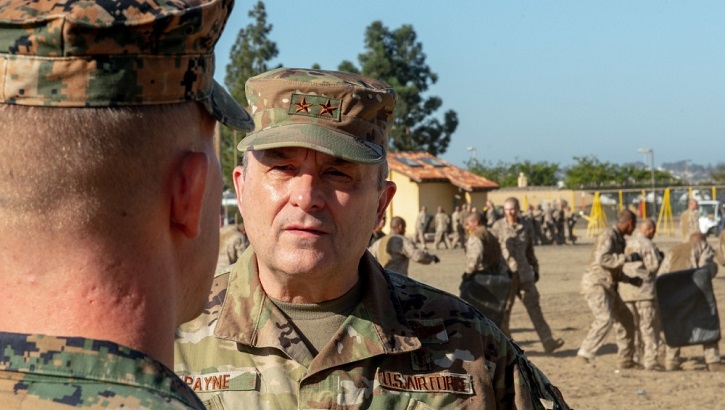
Testing a key next step in the coronavirus fight






















.png)











No hay comentarios:
Publicar un comentario